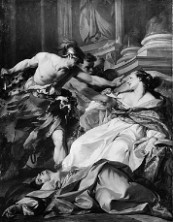|
|
||
|
|
|
|


Julie Oakes Human Sacrifice – Quercia Stories
Rivington Gallery
March 3 to March 27, 2005
69 Rivington Street, East London, Tel: 0207 739-7855
Julie Oakes, 167.6 x 137 cm Jean Baptiste Marie Pierre, 196.9 x 148 cm
Julie Oakes’ first London solo exhibition at Rivington Gallery invokes curiosity and delivers excellent draftsmanship.
“Oakes” translated into Italian is “Quercia.” The exhibition is titled “Human Sacrifice – Quercia stories.” “Quercia Stories,” the first of three exhibitions with novellas, is a diarist journey of libertine encounters into the limits of love and knowledge.
The layered imagery results from a discipline of drawing from existing museum collections. Containing references to Victorian, Indian, Japanese and Aztec erotic art; self portraits and sensual underpinnings tantalize.
An open hardcover book is in the front window backed by a room filled with large black framed and matted renaissance-style drawings on golden parchment paper. Depictions of nude torsos, lingerie, fauna and classical busts are juxtaposed with cursive writing and inspire reflection as to their origins.
The Rivington exhibition consists of over fifty original pencil drawings, three oil paintings and Oakes’ first published novella, “Quercia Stories.”
Oakes’ painting titled “Death of Harmonia”, is the largest of three paintings in the exhibition. It is also a visual reference for her own didactic human sacrifice.
“The Death of Harmonia” was originally painted by Jean Baptiste Marie Pierre (French, 1713–1789). Harmonia, the daughter of the king of Syracuse, was threatened by a band of conspirators who had murdered her family. To save her life, she exchanged clothes with a slave girl who, dressed as the princess, was murdered. Moved by the courage of the girl, Harmonia revealed her identity and was also killed. (Metropolitan Museum)
Like the drawings, Oakes superimposes. In “Death of Harmonia”, she has added the pillar, intrusive dog and her signifier of sexual entanglement – the twisted lizards.
In Oakes’ narrative, as described by the main character, Justine Quercia, her own human sacrifice is stated. “I am granting to this quest the gift of my experience. I, Justine Quercia, am sacrificing my life, my time. I am featuring and sharing my blood. The careful journal entries, the immersion in sexual permissiveness and risk-taking, the willingness to perhaps become a loathed being, an unwomanly, immodest woman; has a grand and arrogant precept.”
Whether the viewer quickly browses or takes the time to peel back the layers of polysemous intentions, Oakes delivers a unique offering of visual decadence and literary infusion to her first London viewing.
Joseph Mongeon